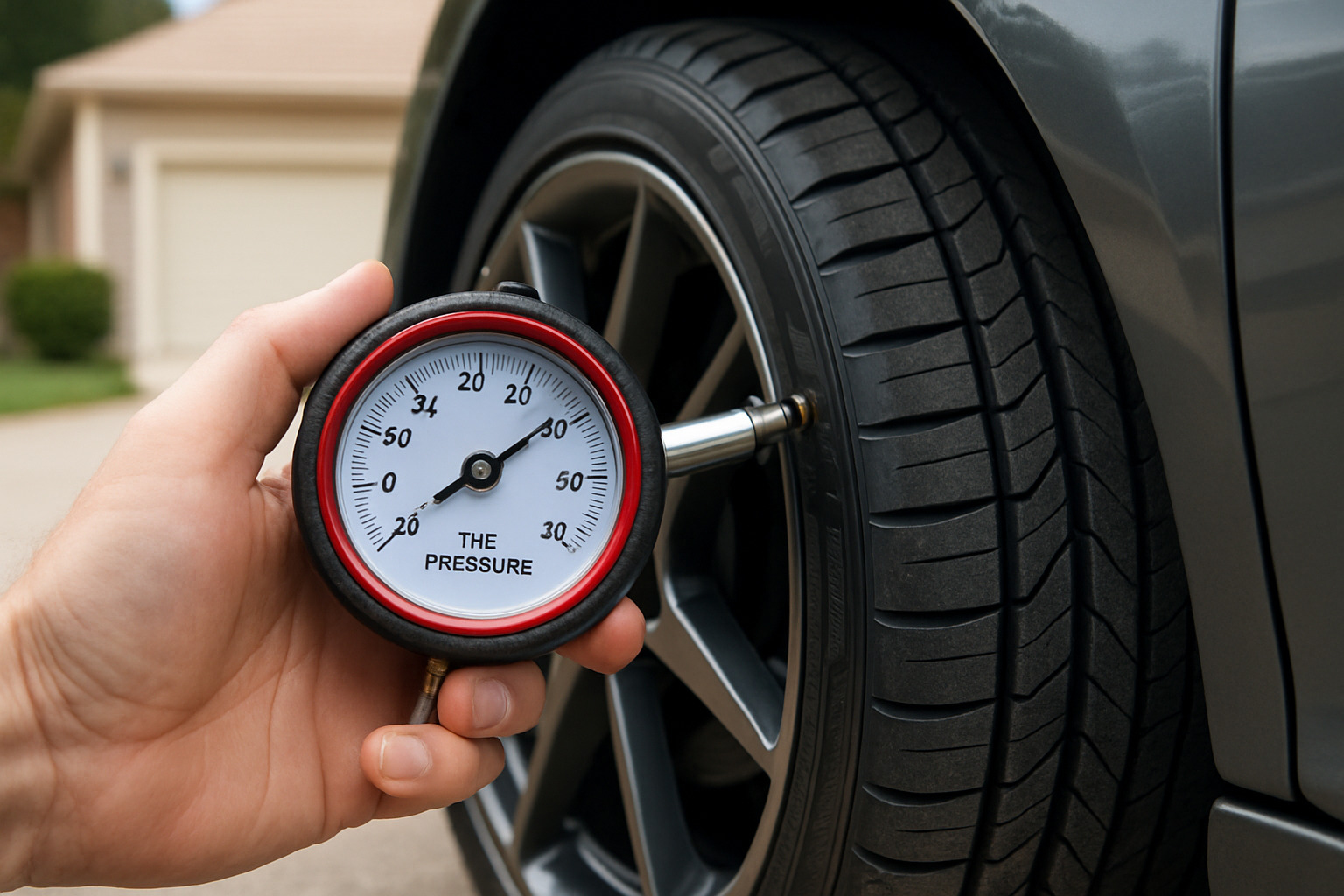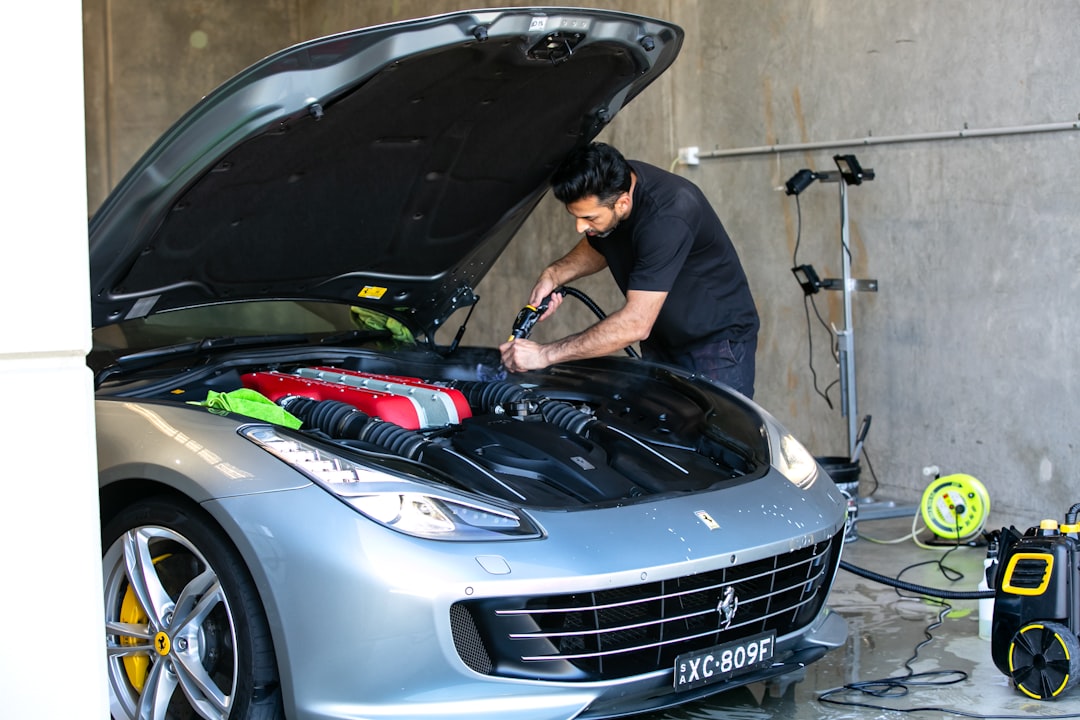Sports Car Maintenance: 10 Essential Tips for 2025 Success
Why Sports Car Maintenance is Critical for Performance and Value
Sports car maintenance requires specialized knowledge and attention that goes far beyond regular vehicle care. While most cars depreciate by 50% in the first three years of ownership, proper maintenance can significantly slow this decline and preserve your investment.
Key Sports Car Maintenance Essentials:
- Oil changes every 5,000 miles (more frequent than regular cars)
- Monthly fluid checks – engine oil, coolant, brake fluid, power steering fluid
- Regular tire inspection – sports cars wear tires 3:1 rear-to-front ratio
- Annual brake system inspection – high-performance driving increases wear
- Professional detailing – protects paint and interior from UV damage
- Convertible roof care – cleaning and conditioning every 6 months
Sports cars demand this extra attention because they use lightweight components, specialized fluids, and operate at higher tolerances than standard vehicles. Their performance-focused engineering means parts experience increased wear, especially during spirited driving.
The good news? Some sports cars are surprisingly affordable to maintain. The Mazda MX-5 Miata costs just $429 annually to service, while the Lexus RC F averages $754 per year – proving that high performance doesn’t always mean high maintenance costs.
Your owner’s manual contains the specific maintenance schedule for your model, but sports cars typically need more frequent attention than the standard 10,000-mile intervals many manufacturers suggest for regular vehicles.

Common sports car maintenance vocab:
Understanding the Unique Demands of Sports Cars
Think of sports car maintenance like caring for a thoroughbred racehorse versus a farm horse. Both are horses, but one is bred for performance and needs completely different care. Your sports car is the automotive equivalent of that thoroughbred.
The engineering that makes your car thrilling to drive also makes it more demanding to maintain. Those lightweight components like aluminum body panels, carbon fiber trim, and magnesium wheels aren’t just there to look pretty – they’re engineered for speed and agility rather than durability. This means they need more careful attention than the steel components on your daily driver.
Your high-performance engine operates at tighter tolerances and higher temperatures than regular engines. While your neighbor’s sedan might run fine on whatever oil is cheapest at the auto parts store, your sports car’s engine is pickier. It needs specialized fluids designed for extreme conditions, and it’s more sensitive to oil quality, coolant concentration, and fuel octane ratings.
The reality of performance driving means increased wear on everything. Those weekend canyon runs and track days put exponentially more stress on components than highway cruising. Brake pads that might last 40,000 miles on a sedan could wear out in 15,000 miles on a sports car driven enthusiastically.
This is why service frequency needs to increase. While Toyota recommends 10,000-mile oil changes for their Camry, the Supra benefits from 5,000-mile intervals to protect its turbocharged engine. Scientific research on depreciation impact shows that proper maintenance significantly reduces the typical 50% value loss in the first three years.
Sports Car Maintenance vs Regular Maintenance
The difference between sports car maintenance and regular vehicle care isn’t just about doing things more often – it’s about understanding that your car has unique parts and higher tolerances throughout its engineering.
Your sports car uses specialized fluids designed for extreme conditions. That transmission fluid for your Porsche might cost $30 per quart compared to $8 for conventional fluid, but it’s engineered to handle the heat and stress that would break down regular fluid in minutes.
Parts are often model-specific rather than mass-produced. A brake rotor for a regular car might cost $50, while the same component for a high-end sports car could be $500. This isn’t price gouging – it’s the reality of low-volume, high-performance manufacturing.
Those tighter clearances throughout your drivetrain mean contaminated oil causes damage faster. Engine clearances measured in thousandths of an inch don’t leave room for error.
Signs Your Sports Car Needs Immediate Attention
Learning to recognize warning signs can save you thousands in repair bills. Unlike regular cars that might limp along with minor issues, sports cars can suffer catastrophic damage quickly when problems develop.
Overheating is the biggest enemy of high-performance engines. If your temperature gauge climbs above normal, even briefly, stop driving immediately. We’ve seen aluminum engines warp from just minutes of overheating, turning a $200 thermostat replacement into a $15,000 engine rebuild.
Brake fade during spirited driving is another red flag you can’t ignore. If your brake pedal starts feeling spongy or requires more pressure, don’t wait for your next service interval.
Fluid leaks deserve immediate attention in sports cars. A small oil leak that might be acceptable in a commuter car can spell disaster for a high-revving engine.
Warning lights on your dashboard should never be ignored. Modern sports cars have sophisticated monitoring systems that detect problems before they become catastrophic.
Essential Sports Car Maintenance Checklist
Taking care of your sports car doesn’t have to be overwhelming. We’ve put together a practical sports car maintenance checklist that covers everything your high-performance machine needs to stay healthy and happy.
Oil changes every 5,000 miles are absolutely essential, even if your manufacturer suggests longer intervals. Your sports car’s engine works harder than a regular car’s engine, running at higher temperatures and RPMs. This breaks down oil much faster than you might expect. We always use high-quality synthetic oil and replace the filter every time.
Monthly tire inspections can save you from expensive surprises and keep you safe. Sports cars typically wear their rear tires about three times faster than their fronts due to how power gets delivered to the road. Check for weird wear patterns that might mean your alignment is off, and always keep proper air pressure.
Your brake system needs annual flushes, not the every-three-years schedule that works for regular cars. High-performance driving creates heat that literally cooks brake fluid, turning it into something less effective than water.
Monthly fluid top-ups are part of sports car life. These engines naturally consume some oil, especially during break-in periods or after track days. Coolant levels can drop from heat cycling, and power steering fluid works harder in performance applications.
Professional detailing every six months isn’t about vanity – it’s about protection. UV rays, brake dust, and road debris can permanently damage paint and interior surfaces that cost thousands to replace. More info about Car Maintenance Tips offers additional guidance on protecting your investment.
Sports Car Maintenance Fluids You Must Check Monthly
Understanding what goes into your sports car is like knowing what to feed a thoroughbred horse – the wrong stuff can cause serious problems. Each fluid has a specific job, and sports car maintenance means being picky about what you use.
Engine oil is absolutely critical in high-performance engines. These powerplants often require full synthetic oils with very specific thickness ratings. Never try to substitute conventional oil or use the wrong grade. Check your oil level weekly if you drive aggressively, because consumption can jump dramatically during spirited driving or track use.
Coolant concentration matters more in sports cars because they run hotter than regular engines. Use a 50/50 mixture of distilled water and the coolant your manufacturer specifies. Tap water contains minerals that can create scaling in aluminum engines.
Brake fluid degrades faster in performance applications because of all that heat cycling. Most sports cars need DOT 4 fluid at minimum, with many requiring DOT 5.1 for track use. Brake fluid actually attracts moisture from the air over time, which lowers its boiling point and can cause brake fade when you need stopping power most.
| Fluid Type | Check Frequency | Replacement Interval | Special Requirements |
|---|---|---|---|
| Engine Oil | Weekly | 5,000 miles | Full synthetic, correct viscosity |
| Coolant | Monthly | 2 years/30,000 miles | 50/50 distilled water mix |
| Brake Fluid | Monthly | Annually | DOT 4 minimum, DOT 5.1 for track |
| Power Steering | Monthly | 50,000 miles | Manufacturer-specific fluid |
| Washer Fluid | Monthly | As needed | Bug remover formula |
Sports Car Maintenance Warning Signs in Tires & Brakes
Tires and brakes are your sports car’s primary safety systems, and unlike regular cars where problems develop gradually, sports car components can fail suddenly during aggressive driving.
Tire pressure monitoring should become second nature for sports car owners. Even 5 PSI low can dramatically change how your car handles and increase tire wear. Check pressure when tires are cold, ideally before driving anywhere.
Tread depth becomes critical for safety in sports cars. While 2/32″ might be legally acceptable, sports cars need more tread for wet weather traction and performance. We recommend replacement at 4/32″ for summer tires and 6/32″ for all-seasons.
Rotor wear inspection should happen every oil change because sports car rotors work much harder than regular ones. Most rotors have minimum thickness specifications stamped right on them. Look for scoring, heat spots, or blue discoloration that indicates overheating.
Brake pad thickness monitoring is crucial for both safety and protecting your rotors. Most sports cars have wear indicators that squeal when pads need replacement, but don’t wait for this warning. Inspect pads visually every few months – they should have at least 3mm of material remaining.

Advanced Care: Protecting Performance and Longevity
Basic upkeep only scratches the surface of sports car maintenance. To keep performance sharp and paint flawless, add the advanced steps below to your routine.
- Ceramic coating – a 2–5 year shield that repels UV rays, bird droppings and light scratches. Expect $1,000–3,000 for pro application, but it’s still cheaper than repainting.
- Paint-protection film (clear bra) – front bumper, hood and mirrors are chip magnets. Film runs $1,500–2,500 and prevents costly bodywork later.
- Leather conditioning – every 3–4 months keeps bolsters supple and crack-free.
- Convertible-roof care – use fabric-specific cleaner twice a year; re-waterproof and keep drains clear to avoid interior leaks.
- Enclosed transport – the safest way to ship valuable cars long distance. Scientific research on enclosed auto transport benefits backs the extra protection.
Cleaning & Detailing Best Practices
- Two-bucket wash to avoid swirl marks.
- Clay bar 2–3× yearly removes embedded contaminants.
- Synthetic paint sealant lasts 6–12 months, out-performing wax.
- Dedicated wheel cleaners keep expensive rims free of corrosive brake dust—see Sports Car Repair Shop for pro help.
Caring for Convertible Tops
- Use only automotive fabric cleaner and UV protectant every 6 months.
- Lubricate seals lightly with silicone spray.
- Verify drains are clear; a quick shot of compressed air prevents cabin floods.
These protective measures take a few weekend hours a year but can save thousands over the life of the car.
Cost, Scheduling, and DIY vs Professional Decisions
Good news: many modern sports cars don’t demand exotic-car budgets. Plan ahead and the numbers stay friendly.
- Mazda MX-5 Miata: ~$429 per year
- Nissan 370Z: ~$504 per year
- Lexus RC F: ~$754 per year
Over 10 years, a Toyota Supra averages $4,950—similar to a family sedan. Tracking costs in a service log (receipts + mileage) protects resale value and helps spot trends before they become problems.
Budgeting for a Decade
- Japanese models generally have lower parts costs; European cars can be 5–10× higher.
- Specialist labor runs $150–200 hr, but expertise often shortens billable time.
- DIY saves money on simple jobs—oil, filters, brake pads—when you have the right jack stands, torque wrench and code reader. Essential Tools can guide purchases.
DIY vs Professional
| Task | DIY Friendly? | Notes |
|---|---|---|
| Oil & filter | Yes | Follow torque specs, use quality synthetic |
| Brake pads/rotors | Sometimes | Requires proper bleeding & torque |
| Engine diagnostics | Rarely | Needs manufacturer-specific software |
| Suspension tuning | No | Safety-critical; specialist alignment tools |
Warranty still active? Read the fine print—some brands require dealer documentation for coverage.
Preparing Your Sports Car for Seasonal and Lifestyle Factors
Weather and driving style change how you approach sports car maintenance.
Winterizing Your Sports Car
- Test antifreeze for at least –20 °F protection.
- Connect a battery tender to avoid parasitic drain.
- Add fuel stabilizer and run the engine a few minutes.
- Inflate tires to max side-wall pressure or store the car on jack stands.

Track Day & High-Speed Use
- Pre-track inspection: check pad thickness, rotor cracks, fluid levels.
- Post-event fluid change: oil, brake fluid and sometimes coolant after 2–3 events.
- Upgrade to track-rated brake pads and verify alignment before next session.
Following these condensed steps keeps the car safe and ready, whether it’s hibernating in January or chasing apexes in July.
Frequently Asked Questions about Sports Car Maintenance
How often should a sports car be serviced?
Use 5,000-mile oil changes and a 12,000-mile (or annual) comprehensive service as a baseline. Track use or extreme climates may require shorter intervals.
Which components hurt your wallet most?
- Engines: $15k–30k
- Dual-clutch transmissions: $8k–15k
- Carbon-ceramic brake sets: $8k–12k (standard steel sets are far cheaper)
- Adaptive dampers: $2k–4k per corner
Preventive maintenance keeps these parts healthy and delays big expenses.
Does regular maintenance raise resale value?
Yes—complete records can lift resale 15–25 %. Keep every invoice and photograph major services. Buyers pay more for cars that show consistent care.
Conclusion
Taking care of your sports car isn’t just about following a maintenance schedule – it’s about preserving the heart and soul of what makes these machines special. Throughout this guide, we’ve explored how sports car maintenance differs from regular vehicle care, and why that extra attention makes all the difference in your ownership experience.
The numbers tell a compelling story. While sports cars might seem intimidating to maintain, models like the Mazda MX-5 Miata cost just $429 annually to keep running perfectly. Even performance icons like the Lexus RC F average only $754 per year in maintenance costs. These figures prove that smart sports car ownership doesn’t have to drain your bank account.
Proactive care is your best friend when it comes to sports car ownership. Those monthly fluid checks, regular brake inspections, and careful tire monitoring we discussed aren’t just suggestions – they’re your insurance policy against expensive surprises. We’ve seen too many owners learn the hard way that a $200 brake fluid flush could have prevented a $3,000 brake system failure.
Performance retention through proper maintenance keeps your sports car feeling like the day you bought it. Regular oil changes with quality synthetic fluids, attention to cooling system health, and proper brake maintenance ensure your car continues delivering those spine-tingling moments that made you choose it in the first place.
Resale value protection might not be your top priority today, but it becomes incredibly important when you’re ready for your next automotive trip. Well-documented maintenance records can add thousands to your car’s value. Sports car enthusiasts know what to look for, and they’ll pay premium prices for cars that have been loved and cared for properly.
At Car News 4 You, we’re passionate about the intersection of automotive innovation and car culture that makes sports car ownership so rewarding. Our expertise in luxury sports experiences gives us unique insight into what these special machines need to perform at their best. More info about ultimate maintenance guide provides even more comprehensive resources for keeping any vehicle in peak condition.
Sports car maintenance isn’t a chore – it’s part of the ownership experience. Those moments spent checking fluids, inspecting components, and keeping your car in perfect condition connect you more deeply with your machine. Every time you slide behind the wheel of a well-maintained sports car, you’re experiencing the culmination of all that careful attention.
Your sports car chose you as much as you chose it. Honor that relationship with the care and attention it deserves, and it will reward you with years of reliable performance, unforgettable drives, and the kind of automotive memories that last a lifetime.







